.
“Life on the [sugar] plantations was extremely hard with a third of newly imported slaves dying within three years. This created a constant demand for new slaves to replace them.”…“The sugar colonies were Britain’s most valuable colonies....Between 1750 and 1780, about 70% of the [UK] government’s total income came from taxes on goods from its colonies.…The Caribbean islands became the hub of the British Empire....Britain dispatched about 10,000 voyages to Africa for slaves” over a period 245 years beginning in 1562 during the reign of Elizabeth 1….Slave Trade was the richest part of Britain’s trade in the 18th century.”…“British Involvement in the Transatlantic Slave Trade,” The Abolition Project…[Image above: African slaves on British ship, schoolhistory.org.uk]
……………………
1994, “The History of Blacks in Britain: From Slavery to Rebellion,” Socialist Alternative
“This article is an edited version of a talk given by Lorraine White to the Panther branch meeting in London in September 1994.”
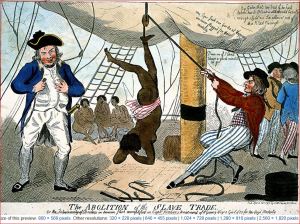 [Image, Copyright The British Museum.
On UK slave ship Recovery traveling from Africa to Caribbean Island of
Grenada in 1791, Captain John Kimber of Bristol hangs a slave girl by
one ankle and flogs her to death, by Isaac Cruikshank]
[Image, Copyright The British Museum.
On UK slave ship Recovery traveling from Africa to Caribbean Island of
Grenada in 1791, Captain John Kimber of Bristol hangs a slave girl by
one ankle and flogs her to death, by Isaac Cruikshank]
“The majority of Blacks and Asians in Britain today trace their origins to the labor migration from the West Indies and the Indian sub-continent which occurred after the Second World War.
However, the presence of Blacks in this country dates back nearly two thousand years. These are records in the British museum which show that African officers and soldiers were part of the Roman army that occupied Britain in 300 AD. Many references to Black people in this country can also be found in the literature of the Elizabethan period.
By the early eighteenth century, Britain had emerged as
the biggest and most prosperous slave trading nation in the world
and the number one slave carrier for European countries.
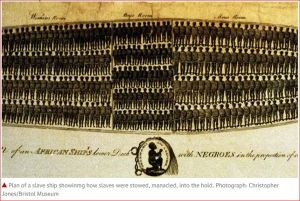 [Image: Bodies of African slaves stowed in holds of UK African slave ships were packed like sardines. Photograph: Christopher Jones/Bristol Museum]
[Image: Bodies of African slaves stowed in holds of UK African slave ships were packed like sardines. Photograph: Christopher Jones/Bristol Museum]
For instance, in July 1757, 175 ships with cargo of tobacco, sugar and cotton docked in British ports. The cargo, worth 210 million at today’s prices is an example of the wealth accumulated by Britain through slavery and the slave trade.
Many of Britain’s seaports became hugely prosperous as a result of the slave trade.
While the great majority of slaves were sold in the [Caribbean colonies sometimes referred to as the] Americas, large numbers were transported to Britain. In 1771, Liverpool sent 106 ships to Africa and came back with 28,200 slaves. Bristol sent 23 ships and returned with 8,810.”…
[Slave lobbyists visit Parliament, 1789: “The West India Interest was formed in the 1740s when British merchants joined with West Indian sugar planters. This was the first sugar trading organisation to have a significant voice in Parliament. For example, in 1789 an assembly of planters from Jamaica visited Parliament to lobby MPs in support of the slave trade.”]
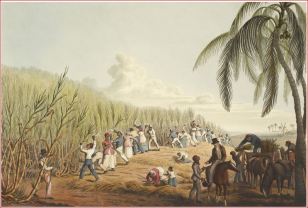 [Image, British slaves: “Enslaved people cutting sugarcane on the Caribbean island of Antigua, aquatint from Ten Views of the Island of Antigua by William Clark, 1832.The British Library (Public Domain)”]
[Image, British slaves: “Enslaved people cutting sugarcane on the Caribbean island of Antigua, aquatint from Ten Views of the Island of Antigua by William Clark, 1832.The British Library (Public Domain)”]
The fabulous wealth generated by slavery and the trading system which thrived around it provided the capital for the development of industry and commerce, which laid the foundations for the birth of modern capitalism. The fact was that the wealth of the Western countries was built on the backs of Black slave labor is a point many historians seem to conveniently forget or ignore.
The development of racism in its modern sense also traces its origins to the role slavery played in the rise of capitalism.
It was during this period that all kinds of pseudo-scientific theories were put forward to justify the brutalities of slavery. These theories purported that Black people were inferior beings, that Africans were in the late stages of the evolution line, that they were half man and half ape, primitive, inferior and without intellect.
The use of science to legitimize and justify slavery paved the way for racism to become a lasting tool of capitalist exploitation.
The Black presence in Britain was greatly enhanced by the coming of the First World War when thousands of Black soldiers from Asia, Africa and the Caribbean were enlisted into the British army.”…
["Lloyds of London underwrote (insured) slave ships. Barclays Bank also began by investing in the slave trade."…“Lloyd’s grew to dominate the shipping insurance market, a key element of Europe’s global scramble for empire, treasure and slaves, who were usually in the 18th Century included in insurance policies in the general rate for ship cargo.“]
Many were sent back after the war but significant numbers stayed. Those remaining were mainly seafarers who settled in the port towns of London, Liverpool, Bristol, Cardiff, Glasgow and Hull.
Despite their relatively small numbers, many of these early Black settlers were confronted with discrimination and racist violence.
[“The Bank of England made capital available for slave voyages and the City of London became the financial centre of the slave trade.“]
In 1918 Charles Wooton was murdered by a white mob in Liverpool. This incident provoked an uprising of Blacks in almost all areas where they had settled. This set a pattern of resistance that was to characterize the Black experience in this country right up to the present day.
The rebuilding of Britain’s shattered economy after the Second World War created a massive demand for labor.
A Royal commission set up in 1949 estimated that 140,000 young people would have to migrate to Britain every year to solve the labor shortage. But the report also noted:
“Immigration on a large scale into a fully established society like ours would only be welcomed without reserve if the immigrants were of good stock and were not prevented by their religion or race from intermarrying with the host population and becoming merged into it.”
[“The Church of England gave its full support to the British slave trade…and also owned a large number of slaves.”]
But large-scale immigration was already becoming a reality despite the “concerns” of the Royal commission as certain sections of industry could not maintain production without it. They sought and found migrant labor from the colonies in the Caribbean and the Indian sub-continent.
During the war the cost of living had almost doubled in the West Indies and the Indian sub-continent. With large scale unemployment, no dole, no children’s allowances, no social security and active encouragement by the government and the employers to come to work in Britain, many made the journey in the hope of a better life.”…
[UK Empire had left West Indies sugar islands for dead: “Another adverse affect of the [British] slave trade was the damage to the Caribbean economies due to the concentration on sugar production. The lasting effects of colonisation are still felt as these countries try to recover their own cultures which were effectively wiped out by colonial domination. The wealth and power accumulated by the rich western world still makes it difficult for colonised countries to become truly self sufficient financially.”]
(continuing): “Most who came had illusions that with British citizenship they would be treated equally and fairly. Their initial intention was not to settle but to stay until they had enough money to return home. These illusions were quickly shattered.
They were housed in slum dwellings in decaying inner city areas and although they had no difficulty in finding employment, they were given the jobs that whites did not want: work with long hours and low pay.
In the late 1950s more than half of West Indian men in London had jobs which were far below their level of skill and experience.
Black workers were concentrated in post offices, building, textiles, factories, railways and hospitals.
They suffered terrible conditions in work and outside of work; they faced discrimination in housing, color bars in pubs and clubs and sometimes physical attacks on the streets. [Following statements made by B. Craddock, House of Commons, May 1953. In 1960, the Queen awarded MP Craddock with Honorary Knighthood in the British Empire]:
“Let us remember that 95% of them are primitive people. One of the reasons why they are not generally accepted into hotels is because their sanitary habits are not all that could be desired… It is well known that a large number of Africans in East and Central Africa are riddled with a disease of a very unfortunate kind…I will not dwell on that very delicate subject but I think that Honorable Members who have experience will agree that the attitude of the African towards women and sexual matters is entirely different from the attitude of the general run of Europeans…it is a common practice among Africans to put children to sleep by excitation of their urogenital organs… The effect of alcohol upon an African is remarkable.I admit that sometimes alcohol has a remarkable effect on Europeans. But speaking generally, alcohol seems to bring out all the evil instincts in the African in the most astonishing way…these views and practices are due to the psychological makeup of those primitive people from time immemorial.” B. Craddock, House of Commons, May 1953
The 1958 Riots
In Nottingham, on August 12, 1958 a fight between whites and Blacks developed into a mass racial attack as white mobs roamed the streets attacking every Black in sight.
Rightwing organizations held their indoor meetings in the area distributing leaflets using slogans like “Act now to keep Britain white”.
Encouraged by fascist propaganda urging that Black people be driven out of Britain, racist attacks were by 1958 a common feature of black life in Britain.On weekend evenings, gangs of teddy boys patrolled the streets looking for West Indians, Africans and Asians.
Predictable, the police did little or nothing to prevent these attacks, an experience that would become familiar for Black people during these subsequent decades.
In London, a second mass attack on Blacks took place in the Notting Hill area. Here, the crowds were much larger than Nottingham. Three to four thousand whites gathered chanting slogans:
“We’ll kill the Blacks” and “Down with niggers”.
They attacked the Blacks in their homes with knives, bottles, crowbars and razors.
Black people responded by organizing escorts for Black London Transport workers on late night and early morning shifts and patrolled their areas in cars.
 [Image: 1749, UK flag flies in West Africa over fort used to collect slaves before loading onto slave ships. “The British built coastal forts in Africa where they kept the captured Africans until the arrival of the slave-ships.”]
[Image: 1749, UK flag flies in West Africa over fort used to collect slaves before loading onto slave ships. “The British built coastal forts in Africa where they kept the captured Africans until the arrival of the slave-ships.”]
(continuing): “Unfortunately the Black and Asian organizations which existed at that time were mainly cultural associations and community groups.
Their major focus was not on what was happening in Britain but what was going on back home. However the events of 1958 began transforming their outlook and they began adopting a more militant stance in Britain.
The politicians responded to the riots with calls for immigration controls. Although it was whites attacking Blacks, Black people were blamed for the disturbances.
Two Nottingham MPs, one Labour and one Tory were among the first to call for immigration controls. They quickly gained sympathy from other MPs.
Typical of the arguments used at the time was that of Labour MP for Kensington North, Mr. Rogers, who told the Times that the“immigrants” were occupying accommodation “which is needed by white people”. He also told the Daily Sketch that:
“The government must introduce legislation quickly to end the tremendous influx of colored people from the Commonwealth… Overcrowding has fostered vice, drugs, prostitution and the use of knives. For years the white people have been tolerant. Now their tempers are up.””…
[*“It wasn’t until 1838 that slavery was abolished in British colonies through the Slavery Abolition Act, giving all slaves in the British empire their freedom….When the Slavery Abolition Act was passed, there were 46,000 slave owners in Britain, according to the Slave Compensation Commission….British slave owners received a total of £20m (£16bn in today’s money) in compensation when slavery was abolished.”]
(continuing): “But the Tories were the main campaigners calling for tough immigration controls and blaming Black people for everything that was wrong in the country.
With their control of the press, numerous articles were carries calling for immigration restrictions. Racial feelings were running high as more and more white people were being told that Blacks were swamping “their” country creating bad housing and unemployment.
This is one of the reasons why the Conservative party were returned to government after the 1959 elections.
Because of all the talk about imposing immigration control, there was a rush of immigration from the West Indies and the Indian sub-continent as many attempted to get here before the controls were introduced.
The Tory government introduced the Commonwealth Immigration Act in 1962. The Act meant that Black people could enter Britain only if they possessed an employment voucher, were dependent on someone living here, or were students. There were 3 types of voucher;
a) those who had a specific job to come to.
b) those who were skilled in a job which was in short supply in Britain, and
c) those who had served in the British armed forces during the war.
Because there was still a labor shortage,the government used the Act not to stop people coming into the country, but to pick and choose what types of Blacks were let in.
The race and immigration issue was now emerging as a central issue in British politics. Peter Griffiths, a Tory candidate at Smethwick, Birmingham, fought the 1964 election on an openly racist platform with the slogan:
“If you want a nigger neighbor, vote Labour.”
Even though Labour won the general election, Peter Griffiths gained the Smethwick seat from Patrick Gordon Walker, one of Labour’s most prominent leaders.
When elected to power in 1964, Labour announced its intention to introduce a Race Relations Bill, but this was a sop to Blacks as the same Labour government also called for further restrictions on the Commonwealth immigrants.
They justified this by saying that they could only promote racial equality for those already in Britain by restricting the numbers coming in. In other words Black people were the problem. This was all part of what Black activists at thee time called “the numbers game”.
The racist activity during this period changed the whole climate for Black people in Britain. Of all the discrimination that they suffered in Britain, they had never seen it so before in politics.
The increasing sharpness in the racial situation meant that Blacks had to develop a more radical approach to deal with racism.
Moreover, there were big developments on the international scene. In the USA, the civil rights movement had just completed their huge march on Washington,Black Power and Malcolm X was drawing huge crowds in Harlem, Liberation movements were sweeping Africa and many of the Caribbean islands had won independence.
It was during this period that the most important anti-racist movements were born.
In December 1964, during a stopover in London, Martin Luther King helped bring together the West Indian Standing Conference, the Indian Workers Association and the National Federation of Pakistani Associations.
The result was CARD – Campaign Against Racial Discrimination. CARD’s aims were to eliminate racial discrimination and oppose the racist immigration laws.
A more militant Black organization RAAS – Racial Adjustment Action Society, was formed in 1965. The aims and objectives of this organization were to guarantee the human rights of Black people, to reexamine the question of Black identity and to strengthen links of Afro-Asian-Caribbean people in the common fight for the freedom and dignity of man.
Both these organizations had a fairly large membership and reflected the more militant mood in the Black community. RAAS adopted a more Black nationalist stance while CARD was a mixture of radicalism and liberalism.
Neither were able to sustain their size as the organizations fractured on the kind of response which was necessary to tackle the racial and class dimensions of the Black struggle.
In August 1965 the Labour government issued its white paper on immigration beginning a new round on “illegal immigrants” scare stories in the press. As a result, immigration was further tightened with the government issuing just 8,500 employment vouchers which were only given to skilled workers and professionals.
Labour attempted to soften the blow when a year later the Race Relations Act which forbade discrimination in “places of public resort” was passed.
But Black people saw it for what it was. They knew that it would make little difference to their lives. There was now an understanding that only active struggle could secure rights for black people.
Several demonstrations against racial discrimination were now organized. More Black groups and campaigns were set up including a small branch of the Black Panther Party formed in 1967.
In 1968 the race/immigration issue was once again at the center of British politics. That year the Labour government rushed through the Commonwealth Immigrations Act. Known as the Kenyan Asian act, this law was designed to deny citizenship rights to Asians in Kenya who held British passports.
Its racist designs were clear, as a special clause in the Act gave white ex-colonials continued right of entry into Britain.
Again the race issue was stoked up in the press with every utterance of the racist Tory MP Enoch Powell given extensive sympathetic coverage in the newspapers.
Powell called for a total ban on all Asians coming into the country and for an end to the voucher system. On April 20, 1968, in Birmingham he gave his “Rivers of Blood” speech saying that racial conflict would not end until all Blacks went home. His speech inspired racists all over the country.
White dockers and Smithfield porters marched to the House of Commons in response to criticisms by other MPs of Powell’s speech.
A series of vicious attacks on Blacks immediately followed the Powell’s outburst. In Smethwick, a Jamaican was shot and killed. In north Kensington a Black school boy was attacked and almost killed by a gang of whites armed with iron bars, axes and bottles. Ku Klux Klan style crosses were burnt outside Black people’s homes in Leamington Spa, Rugby, Coventry, Ilford, Plaistow and Cricklewood.
It was partly on this racial tide that the Conservatives won the 1970 general election. To fulfill their propaganda they passed another Immigration Act in 1971 which came into force in 1973. Couched in legalistic phraseology, essentially the act was designed to further restrict Black immigration (referred to as “partials” in the act) while extending the rights of several categories of whites (non-partials) to enter Britain freely.
By this time Powell and the other open racists in and outside parliament were calling for a “Ministry of Repatriation”.
The purpose of all these acts was not so much to restrict further immigration but to whip up racism since the numbers coming in were relatively small. In this way all social ills could be blamed on Blacks and the population presented with a simple solution: “get rid of them”.
Hence it was quite easy for the Tory government and the press to begin manufacturing the “Black crime scare” in the 1970s. It also provided them with an opportunity to specifically target Black youth.
This new “second generation” of Blacks had grown up with British racism and unlike their parents had no illusions or allegiance to “Queen and Country”. As early as 1969 the government’s Select Committee on Race Relations described Black youth as “a social time-bomb”.
Their strategy was to harass and criminalize Black youth. For these youth a new crime was invented: mugging. The term had been taken directly from America and was commonly used in the 1940s to refer to street robberies which involved violence.
All of a sudden, scare stories appeared in the press recounting horrific attacks by Black youth on whites for money. The systematic harassment of Black youth was now justified and the police eagerly went about this business.
Labour returned to power in 1974 after a huge movement by the miners brought down the Tory government of Edward Heath. 1974 was also the year of the first worldwide economic recession since 1945.
The new Labour government came under pressure from workers to solve the problems of rising unemployment and falling living standards.
The government failed to respond. Giving into pressure from the big employers, the Labour government carried out a series of counter-reforms, cutting living standards further.
The ruling class through their press and media unleashed another round of racist propaganda. The fascist national Front came to the fore gaining 120,000 votes in the Greater London Council elections of 1976. They came second in six Leicester election wards and even gained a council seat in Blackburn.
The National Front also organized several provocative marches through Black areaswith full police protection. In one instance National Front co-leader, Martin Webster marched alone through Moss Side in Manchester, protected by 4,000 policemen.
There were several racist murders and over 1,000 serious racial attacks.
It should come as no surprise that the 1976 Notting Hill Carnival saw the biggest street disturbances in this country since the war, as thousands of Black youth clashed with police.
This was the voice of the second generation of Black people. Angered by their treatment at the hands of the police their frustrations were vented that day in August.
But it was not just a question of frustration. Political meetings in Black areas were now commonplace as Black people began to organize and channel their anger.
In 1977 for example, the predecessors of the current Panthers set up the organization; the PNP youth movement. This was a radical Black group with a significant national membership which organized demonstrations against the activities of the fascists.
It was also in that year that the fascists suffered a crucial defeat as they attempted to march through Lewisham. They were met by a huge counter-demonstration and although they were protected by the police, they received a severe beating and were prevented from marching.
They never quite recovered after this defeat but the heightened racial climate of the 70s had taken its toll. Between 1976 and 1981, 31 Black people in Britain had been murdered by racists. In almost all the cases of the racial attack, the police arrested the victims rather than the perpetrators. In the face of overwhelming evidence, the police were always eager to deny that the murders were racially motivated. Even now the police still refuse to recognize racial attacks as a specific crime.
Another reason for the dying fortunes of the NF was that, to a large degree, the Tories, then in opposition, had stolen their clothes.
In an interview on London Weekend Television, Margaret Thatcher referred to Britain as being swamped by an alien culture. This was the first time a leader of a major political party made an attack of this kind so openly. A few weeks later the Tories under won the general election.
The harassment of Blacks by the police under the newly elected Tory government intensified. Using an old law, Section 4 of the Vagrancy Act 1824, known as SUS (short for suspicion), the police were given wide powers of arrest. This law was originally used to clear tramps and “vagabonds” off the streets of Victorian Britain.
Afro-Caribbeans accounted for 44% of arrests under SUS while they made up only 6% of the London population. In some boroughs such as Lambeth, 77% of arrests for SUS were Black people.
Specialist police units such as the Special Patrol Group carried out stop and search swoops in Brixton. In one Brixton raid alone, 430 people were arrested.
Still racial violence had not died down. In January 1981 racists set fire to a house in Deptford, London, during a party, killing 13 Black youths.
Not surprisingly, police failed to find the attackers. A huge demonstration of over 20,000 Black people were mobilized onto the streets of London on a march from Deptford to Hyde Park.
All this was a prelude to the massive street disturbances which occurred in 1981.
A year earlier, the warning signs were there as in Bristol, rioting occurred on April 2, 1980 after a raid on a Black cafe. 22 policemen were injured and 27 police cars were damaged.
Beginning on April 6, 1981, 943 people were stopped and searched in Brixton and 118 of them arrested in just 4 days of what the police codenamed “Operation Swamp”.
Crowds began to gather whenever the police were making arrests. Eventually, unable to suffer the indignities any further, Brixton exploded.
The rioting was concentrated on Railton road, Atlantic road and Mayall road. Shops, pubs and houses were set alight and by the time it was over, 145 buildings and 207 vehicles, including fire engines and police cars were damaged.
7,000 police officers were bought into the area to “restore peace”. 450 people, including policemen were injured. The damage to property totaled 6.2 million.
Rioting erupted again in Liverpool on Saturday July 4, for similar reasons as the Brixton riots. But these were even more serious than the Brixton riots. For the first time on the British mainland, CS gas was used against the crowds.
The rioting lasted for 4 days and there were 705 arrests. 781 policemen were injured and one disabled person was killed by the police.
Moss side, Manchester on Wednesday July 8 was the next place to erupt. On Friday July 10 there was again rioting in Brixton after Lloyd Coxone, a local Rastafarian was arrested. This time the rioting lasted 7 days.
There were also disturbances in Lewisham, Balham, Stoke Newington, Fulham and Woolwich. In all, there were serious disturbances in 40 cities and towns that year.
The upheavals of 1981 marked an important turning point in the British establishment’s approach to the race question. The uprising had taught them that crude repression alone could not hold Black people in check.
It was now seen as necessary to combine repression with reform. Underlying this new carrot and stick approach was a strategy first signaled in the Scarman report into the Brixton disorders; to buy off a section of the Black community or as Scarman himself later said “to create a Black middle class”.
This strategy was put into operation in the 1980s. Former community leaders were drawn into the state machine and given jobs as “race advisers” and “equal opportunity officers”.
Entrepreneurs were encouraged to set up Black magazines and newspapers whole columns supported Black participation in free enterprise initiatives.
Suddenly, Blacks were promoted as TV presenters, sports personalities and senior officers in local government. These measures were designed to give the impression that we were now making it in Britain.
This strategy which was much more widely applied in America in the wake of the huge inner city disturbances in the 60s and 70s has completely failed to solve any of the fundamental problems facing African Americans.
It has been even a greater failure in Britain. Social conditions for the mass of Black people in this country have worsened.
The so-called Black middle class in Britain is so small it is not worth counting. In the eighties, the long economic boom to some extent at least masked the deep rooted problems in the Black and Asian communities.
Now the mask is off, youth are returning to the radical ideas of Malcolm X and the Panthers. It was in the midst of this rising Black consciousness that Panther was formed to develop and transform this consciousness for the advancement of our struggle in Britain.”
Lorraine White
………………………………………
In 1953, MP Craddock famously said of blacks, “that 95% of them are primitive people….It is a common practice among Africans to put children to sleep by excitation of their urogenital organs.” [If that’s true, why did your country seize millions of African parents and children and pack them like sardines on your slave ships where the children would be guaranteed to be molested?]
“HONOURS AND AWARDS HOME OFFICE Whitehall, London S.W.;. 8th July 1960. The QUEEN was pleased on Tuesday, 5th July, at Buckingham Palace, to confer the honour of Knight-hood upon the undermentioned gentlemen:…
[Her Majesty’s approval of these Knighthoods was signified on 1st January I960.]…
George Beresford Craddock, Esq., M.P.”…
……………………………………………
Added; On a British Empire slave ship crossing from Africa to the Caribbean Island of Grenada in 1791, an African slave girl was hung by one ankle and whipped to death as depicted in copyrighted image.
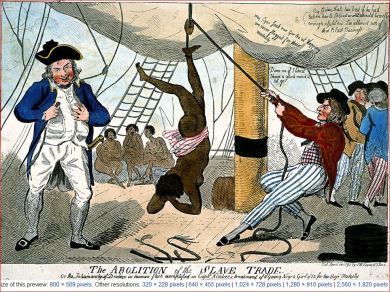 British slave ship Recovery was owned by Bristol merchants. In 1791 an enslaved African girl was whipped to death for refusing to dance naked on the deck of the ship. At right, a sailor is seen suspending the African girl by her ankle from a rope over a pulley. The ship’s captain, John Kimber, left, holds a whip. Back in England, Captain Timber was tried for murder but acquitted. He was merely denounced before the House of Commons over the alleged incident….Image attributed to Isaac Cruikshank.…”Cruikshank’s depiction of the alleged murder of a slave girl by John Kimber, published April 10, 1792.“…”…Image is “Copyright The British Museum.”
British slave ship Recovery was owned by Bristol merchants. In 1791 an enslaved African girl was whipped to death for refusing to dance naked on the deck of the ship. At right, a sailor is seen suspending the African girl by her ankle from a rope over a pulley. The ship’s captain, John Kimber, left, holds a whip. Back in England, Captain Timber was tried for murder but acquitted. He was merely denounced before the House of Commons over the alleged incident….Image attributed to Isaac Cruikshank.…”Cruikshank’s depiction of the alleged murder of a slave girl by John Kimber, published April 10, 1792.“…”…Image is “Copyright The British Museum.”
“Description: The Abolition of the Slave Trade, showing Captain John Kimber of Bristol flogging a slave girl because she was unwell and could not eat, by Isaac Cruikshank, 1792.
Copyright The British Museum
Creator: Isaac Cruikshank
Date: 1792, Copyright: British Museum”
……………………
Added: “On the voyage across the Atlantic Ocean from Africa to the island of Grenada in the Caribbean, Kimber had punished a female slave.” In 1792 Kimber was tried as tried and found not guilty of murdering the slave girl.
…………………………………………..
“Britain and the Caribbean,”BBC
“In the 17th and 18th centuries slaves were moved from Africa to the West Indies to work on sugar plantations. This industry and the slave trade made British ports and merchants involved very wealthy….
………………………………………….
Added: Without this “partnership,” humanity might have a chance: “In partnership with the United States, we keep the peace of the world:”
“In a controversial speech on 26 May 1967, [MP Enoch] Powell criticised the UK’s post-war world role:
“In our imagination the vanishing last vestiges…of Britain’s once vast Indian Empire have transformed themselves into a peacekeeping role on which the sun never sets. Under God’s good providence and in partnership with the United States, we keep the peace of the world and rush hither and thither containing Communism, putting out brush fires and coping with subversion. It is difficult to describe, without using terms derived from psychiatry, a notion having so few points of contact with reality.[10]:431″
......................
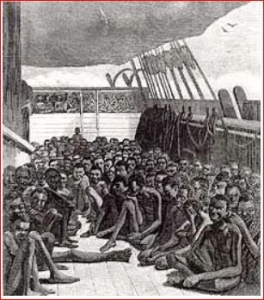
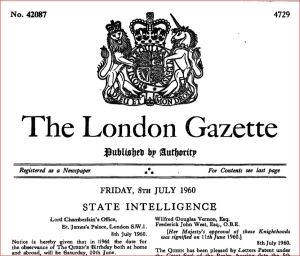
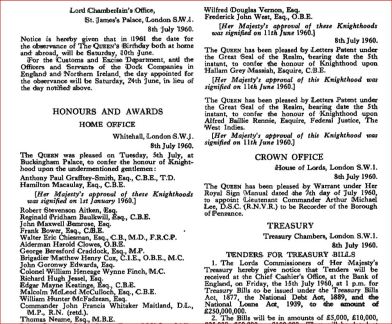

No comments:
Post a Comment